Standing Committees
18 Privileges
-
A Committee of Privileges, consisting of 7 senators, shall be appointed at the commencement of each Parliament to inquire into and report upon matters of privilege referred to it by the Senate.
-
The committee shall have power to send for persons and documents, to move from place to place and to sit during recess.
-
The committee shall consist of 7 senators, 4 nominated by the Leader of the Government in the Senate and 3 nominated by the Leader of the Opposition in the Senate.
-
The committee shall elect as its chair a member nominated by the Leader of the Opposition in the Senate.
Amendment history
Adopted: 2 December 1965, J.427, as SO 33A (to take effect 1 January 1966) (corresponding to paragraph (1))
Amended: 24 August 1994, J.2052 (to take effect 10 October 1994) (composition specified and opposition senator designated as chair – paragraphs (3) and (4))
1989 revision: Old SO 33A renumbered as SO 18 and committee powers specified in paragraph (2)
Commentary

Reports of the Committee of Privileges
Until 1966, the Senate had dealt with matters of privilege on the floor of the chamber. In only one case was a select committee established to inquire into a possible contempt, the case of Senator Lt. Col. Neild (FT, NSW) in 1904. Amongst the matters canvassed by the Standing Orders Committee in 1965, in its first comprehensive review since 1937, was the need for a standing committee of privileges, a facility which the House of Representatives had enjoyed since 1944. The committee recommended a standing committee so that “the Senate would be in a position to deal speedily with any Question of Privilege which might arise”.[1]
From the 1980s, the committee’s workload increased, particularly after the passage of the Parliamentary Privileges Act 1987 and the adoption of the Senate Privilege Resolutions in February 1988. When the standing orders were revised in 1989, the committee’s powers of inquiry were specified by the addition of paragraph (2), to avoid the need for such powers to be conferred separately for each contempt reference, as had previously been the case. This was in keeping with the stated intention of the revision as a “consolidation, clarification and codification of the existing procedures, currently contained in the old standing orders, sessional orders and rulings of Presidents”.[2]
The composition of the committee was left to the Senate until 1994 when, in the context of the restructuring of the legislative and general purpose standing committees and concomitant changes, the current membership formula was adopted (paragraph (3)) and the chair of the committee was designated as an opposition senator (paragraph (4)).[3]